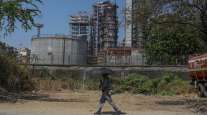DOT Urges Transport Network Improvements to Counter Growing Effects of Climate Change
This story appears in the Nov. 17 print edition of Transport Topics.
Making transportation infrastructure and systems more resilient to the symptoms of climate change is an increasingly significant aspect of planning at the U.S. Department of Transportation, according to a new report.
“Transportation is and will continue to be affected by climate change,” the department said in the report titled, “Climate Action Plan 2014, Ensuring Transportation Infrastructure and System Resilience.”
“The range of impacts from these threats may include roadway deterioration, flooding, limited waterway access and weakened structures. Severe conditions may reduce the life of capital assets and increase operational disruptions,” the Oct. 31 report said.
The report cited Superstorm Sandy, which devastated New York and New Jersey in 2012, as an example of climate change that can damage transportation facilities. Examples of mitigating tactics in the report include hardening existing infrastructure, relocation or abandonment of at-risk infrastructure and adding backups to transportation systems.
“What we see is our transportation network increasingly at risk,” said Joshua Schank, CEO of the Eno Center for Transportation. Coastal areas need particular attention because of the rise in sea level, he said.
Beyond capital assets such as roads, bridges, airports and rail tracks, Schank said it’s critical to look at operational practices in reacting to weather. He mentioned the Atlanta snowstorm earlier this year when widespread sudden closings led to extraordinary traffic jams.
Various state transportation departments have faced dust storms, hurricanes, uncommon heat and forest fires, said a program director for the American Association of State Highway and Transportation Officials.
AASHTO’s Shannon Eggleston said some state DOTs are working with the Federal Highway Administration on vulnerability analysis and risk assessment. Since 2008, the association has worked on reducing carbon dioxide output by improving fuel economy and investigated methods of adaptation.
The cost of dealing with the issue can vary greatly, a DOT spokeswoman said.
“It is important to note that resilient infrastructure is not necessarily more expensive than vulnerable infrastructure,” said DOT’s Susan Hendrick. “Hardening transportation infrastructure to climate impacts involves identifying the future environmental conditions to which specific pieces of infrastructure will be exposed, and making design choices accordingly. The costs associated with these design choices vary on a case-by-case basis.”
Elements of the report made it into the Obama administration’s four-year, $302 billion Grow America Act proposal on surface transportation earlier this year, Hendrick said, a result of the president’s November 2013 executive order on climate change.
In addition to mitigating the effects of climate change, Hendrick said the administration also has pursued lessening the emission of carbon dioxide. Two other federal agencies, for instance, are developing rules on further reducing greenhouse gas emissions from trucks.
The nation’s transportation system includes 3.9 million miles of roads, 120,000 miles of railroad track, 25,000 miles of navigable waterways, 5,000 airports and 300 ports on ocean coasts or the Great Lakes.
Storm surge from a higher sea level was the destructive element with Sandy, but sustained exposure to temperatures about 90 degrees is bad for pavement, especially asphalt. Wider temperature ranges from hot to cold also shorten the lifespan of roads.
Some infrastructure will need to be hardened to withstand difficulties, while other components will have to be relocated or abandoned, the report said. Roads and bridges in the planning stage now should be designed for tougher realities.
FHWA has said adaptation-and-resiliency planning by state and local governments on highway projects is eligible for reimbursement under the Federal Aid and Federal Lands Highway Programs.
Resiliency criteria have been included in the selection factors for DOT’s TIGER, or Transportation Investment Generating Economic Recovery grants, Hendrick said.
The Federal Motor Carrier Safety Administration has little at risk from climate change, the report said, because the agency does not own or manage property. However, FMCSA will conduct an analysis of weather emergencies and truck safety. State governments often waive parts of the Federal Motor Carrier Safety Regulations during emergencies, and FMCSA wants to examine the effects of that on highway safety, the report said.
The report also noted that changes will not be uniform across the nation. Some places, in fact, might actually experience a more desirable pattern of weather. American Trucking Associations’ Glen Kedzie, vice president of environmental affairs and assistant general counsel, said infrastructure is often discussed in terms of repairing existing facilities, but if roads and bridges need to be raised and drainage culverts enlarged, that will affect not only federal spending but state matching funds, too.
“Considering our current disarray in infrastructure, this adds another layer and probably the bill for it goes higher,” he said.




